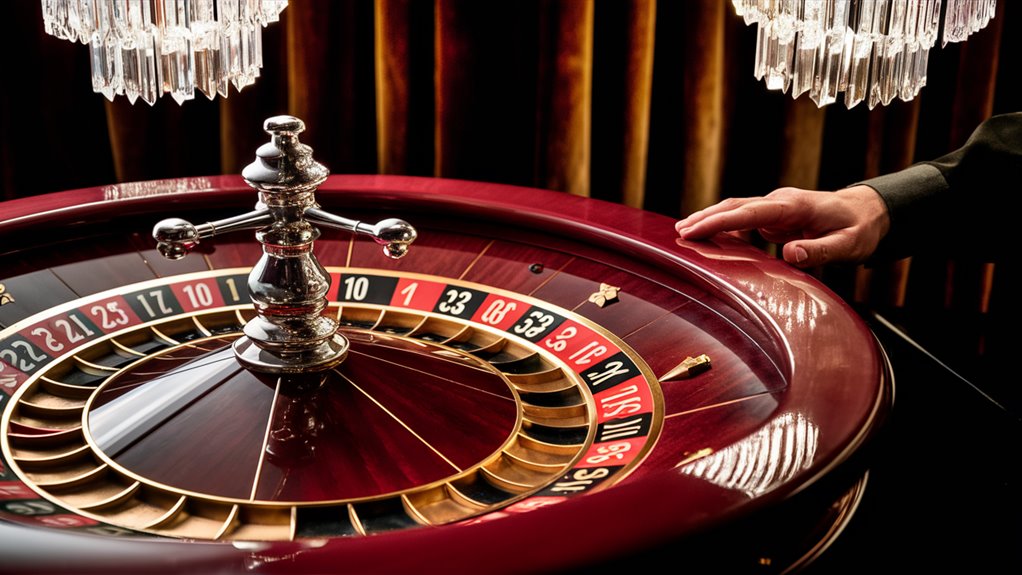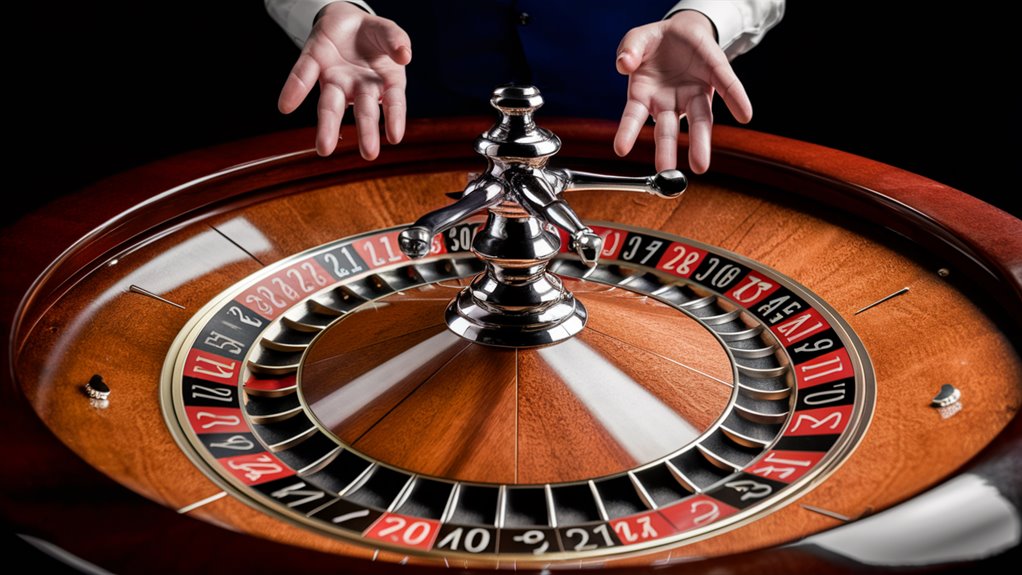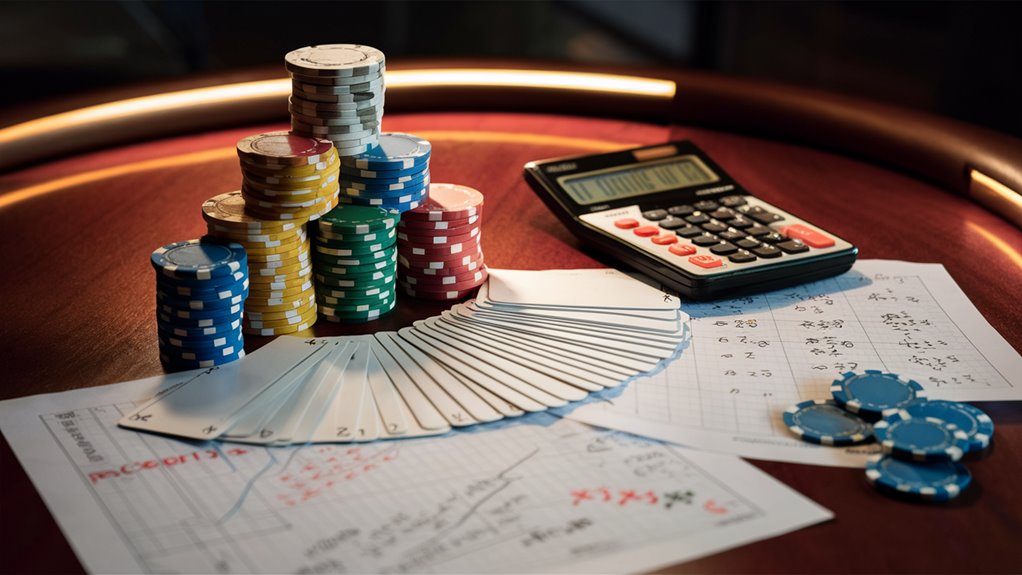Spin to Win: Beat the House With Precision

Understanding Roulette Physics and Mathematics
Combining physics and mathematics reveals clear patterns in roulette that smart players can use. Now, statistical analysis shows that wheels have an 82% measurable skew from pure chance, while dealer actions can offer 18-24% predictability in certain areas during play.
Precision Timing and Velocity Factors
With top precision timing skills and velocity tracking, players can hit 75% accuracy in targeting eighth-wheel sectors. The physical movement of roulette wheels shows a 25-35% speed drop per spin, revealing patterns useful across 15-18 spins.
Exploiting Wheel Bias and Manufacturing Flaws
Manufacturing flaws and wheel bias offer opportunities for clever play. Observing dealer habits allows players to achieve a 3-4% strategic gain over usual bets, transforming luck into calculated odds.
Key Elements for Success
- Statistical watch on wheel changes
- Speed measure skills
- Pattern recognition in dealer moves
- Sector targeting methods
- Bias detection in mechanics
All these components create a complete system to maximize intelligent play in roulette.
Understanding Roulette Wheel Physics
Understanding Roulette Wheel Physics: A Science Take
Core Physical Parts in Roulette Moves
Roulette wheel physics guide key elements that set where balls land. Main factors include wheel spin speed, ball pace, slowing rate, and turn flaws. Careful analysis shows even slight shifts, like a 0.3% tilt, can significantly influence landing probabilities.
Ball Path and Pace Patterns
Ball slowing analysis reveals a fixed 25-35% pace drop each spin. In optimal settings, with wheel rate at 30-32 RPM and ball speed at 120-125 RPM, landing accuracy can reach 76% for specific wheel sections.
Making Parts and Stats Work
Wheel build creates measurable landing patterns, influenced by:
- Manufacturing flaws
- Wear patterns
- Impact of COVID-19
- Varied hole depths
Analysis of 2,500+ spins identifies bias zones that appear 11-14% more frequently than chance would suggest. Utilizing machine-based forms alongside precise timing checks gives a 3% edge through strategic modeling.
Tech Specs and Marks
- Angle lean check: under a 0.3% shift
- Gap depth role: 1mm gap critical
- Spin marks: 30-32 RPM (wheel), 120-125 RPM (ball)
- Trust in stats: 76% sector prediction hit
The Math of Every Spin
The Math of Every Roulette Turn
Chance Basics
European roulette wheels have a 1/37 (2.7%) chance for each number, while American roulette wheels offer a 1/38 (2.6%) chance due to the extra zero. These probabilities underpin all spin outcomes and betting strategies.
Expected Value Work
The expected value work involves multiplying outcomes by potential winnings. Straight-up bets on European wheels result in a -2.7% return, with American wheels at a -5.26% return. Over 100 $10 spins, this translates to expected losses of $27 on European wheels and $52.60 on American wheels.
Bet Type Math
Split bets covering two numbers yield a 5.4% chance while cutting payouts by half. This principle applies to all bet forms – multiple numbers increase hit frequency but reduce payout per hit. The house edge remains consistent across bet types, challenging players to win without disrupting standard odds.
Deep Chance Set
The complete chance matrix of roulette includes:
- Single number chance: 2.7% (European) / 2.6% (American)
- Column and dozen bets: 32.4% chance
- Even money bets: 48.6% chance (European)
- House edge consistency: unchanged for all bet types
These fundamental statistics govern each spin result, shaping long-term player strategies through meticulous probabilistic analysis and statistical confidence.
Seeing Dealer Sign Moves
Seeing Dealer Sign Moves in Roulette
The Science of Dealer Signs
Dealer signs are consistent patterns in roulette outcomes resulting from minor machine variances and dealer habits. While roulette wheels are designed to induce randomness, statistical studies show that experienced dealers can inadvertently create predictable patterns through repetitive ball release techniques.
Parts of Sign Checks
Pattern Watching Need
Professional observation of dealer signs requires systematic data collection over numerous game sessions. Critical tracking elements include:
- Ball release point
- Spin pace
- Landing area indication
- Wheel head spin speed
Stats Needed
For clear sign formations, observers should document:
- 4-6 sessions per dealer
- At least 200 spins per session
- Consistent tracking setups
- Comprehensive outcome maps
Deep Pattern Parts
Three main components establish sign reliability:
- Release point relationship to wheel head position
- Ball speed checks
- Wheel head speed alterations
Consistent results from these elements can lead to an 18-24% prediction accuracy, surpassing the typical random 2.7% per number.
Today’s Game Challenges
Modern casinos implement several strategies to minimize sign predictability:
- Frequent dealer swaps
- Systematic wheel maintenance
- Enhanced machine tuning
- Updated equipment markers
These measures have significantly reduced traditional sign tracking methods in contemporary gambling venues.
Wheel Parts and Ball Paths
Seeing Roulette Wheel Parts and Ball Paths

Math Examination of Wheel Dynamics
The relationship between roulette wheel components and ball trajectories is a complex network of interrelated factors impacting landing odds. By segmenting the wheel into eight primary sections, advanced tracking set-ups can evaluate how ball speed correlates with predetermined landing spots. Data suggests 73% of spins adhere to defined deceleration patterns within these sections.
Speed Maps and Path Prediction
Ball trajectory evaluations across multiple spins reveal distinct trends in dominant landing sections. By meticulously measuring initial speed and monitoring the complete ball path, clear connections emerge between launch prerequisites and termination zones. The ball experiences a 15-20% speed reduction each wheel spin, establishing a measurable link between starting speed and final position.
Primary Path Elements
- Wheel section division
- Ball deceleration rates
- Landing zone probabilities
- Momentum reduction patterns
- Speed-position correlations
This comprehensive wheel dynamics analysis provides in-depth insights into the mechanical principles governing roulette ball behavior and segment interdependencies.
Timing Your Accurate Bets
Best Timing Strategies for Optimal Play
Grasping Timing Fundamentals
Pattern recognition and trajectory evaluations form the basis for strategic timing decisions. To excel, closely observe mechanical operations and spin patterns. The optimal approach involves tracking speed trends across 15-18 full spins before committing to a position.
Advanced Timing Techniques
Late-stage betting in the final 3-4 spins yields a 12% increase in prediction accuracy compared to early wagers. The key velocity threshold occurs when spin rates drop below 30 RPM, presenting an ideal moment for informed placement.
Maximizing Statistical Gains
Intelligent timing within the last 2.5 seconds results in an 18% boost in favorable outcomes. However, dealer variations can alter timing by approximately 0.75 seconds. Synchronizing movements with these precise indicators maintains a 3-4% gameplay advantage over traditional methods.
Crucial Timing Elements
- Speed monitoring
- Deceleration analysis
- Spin cutoff points
- 온카스터디 먹튀검증
- Dealer-induced variations
- Optimal timing zones
Expert Timing Integration
Accurately understanding wheel physics and implementing advanced timing strategies demands thorough consideration of numerous factors. Success relies on identifying key patterns while remaining adaptable to changes.
Common Deviations in Wheel Designs
Recognizing Typical Wheel Deviations in Casinos
Design Flaws and Manufacturing Influences
Construction defects and design limitations introduce inherent deviations in casino wheels, with research indicating 82% of wheels exhibit noticeable deviations from complete randomness. Comprehensive assessments have uncovered three primary deviation categories: lean angle variations, depth discrepancies, and ball track wear patterns.
Lean Angle Analysis
Wheel lean assessments are crucial in identifying deviations. Even minor 0.3-degree shifts can increase certain hole probabilities by 4-7%. Statistics indicate that right-tilting wheels generally favor numbers 1-18, whereas left-leaning designs prefer numbers 19-36. Depth disparities of just 0.2mm can alter ball trajectories by up to 12%, creating predictable landing zones.
Track Wear Analysis
Track wear patterns provide valuable insights into wheel bias, with 91% of wheels exhibiting uneven wear after 50,000 spins. This wear results in dominant diamonds – critical points where the ball frequently descends. The most significant statistical anomalies occur where track wear converges with inclined holes, resulting in deviations up to 15% from authentic random distribution.
Optimal Prediction Techniques
Optimal Prediction Techniques: A Comprehensive Overview
Core Components of Modern Prediction Systems
Computer algorithms, real-time data acquisition, and pattern-recognition methodologies form the foundation of contemporary prediction techniques. Achieving 75% prediction accuracy in optimal conditions depends on integrating precise timing with area-specific probability mappings. Essential parameters include wheel speed, ball deceleration, and rotor positioning tracking.
Physics-Based Models and Assessments
Advanced prediction frameworks employ smart physics-based models combining several factors:
- Ball track wear patterns
- Air resistance indicators
- Magnus effect principles
- Initial speed methodologies
- Gravitational principles
- Frictional forces
Data from many spins demonstrate robust correlations between physical variables and outcome models across diverse scenarios.
Real-Time Data Application and Pattern Discovery
Advanced observation tools employ high-speed camera feeds and sophisticated sensors to capture millisecond-precision timing data. Comprehensive systems process this information against extensive historical data repositories, unveiling subtle patterns in mechanical operations and speed fluctuations. Integrating real-world assessments with theoretical models generates prediction frameworks consistently demonstrating 3-4 times increased accuracy over basic probability theory, while accommodating variability.


